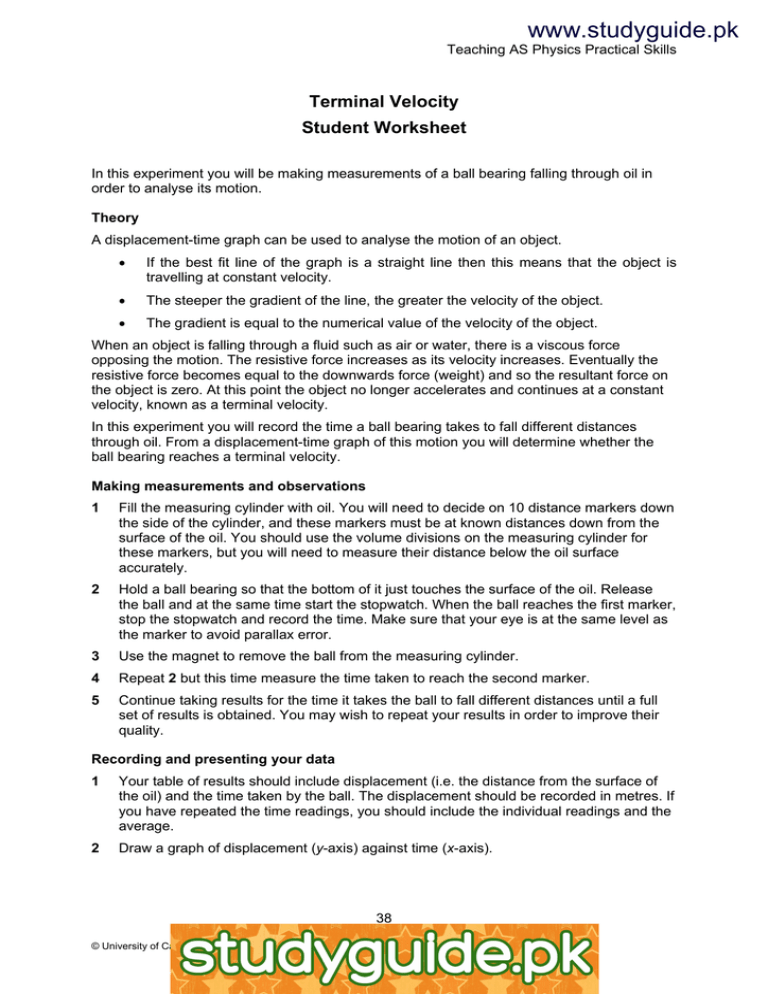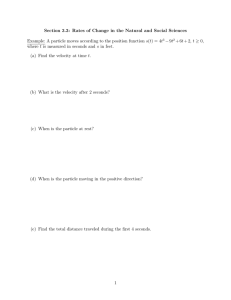www.studyguide.pk Terminal Velocity Student Worksheet
advertisement

www.studyguide.pk Teaching AS Physics Practical Skills Terminal Velocity Student Worksheet In this experiment you will be making measurements of a ball bearing falling through oil in order to analyse its motion. Theory A displacement-time graph can be used to analyse the motion of an object. • If the best fit line of the graph is a straight line then this means that the object is travelling at constant velocity. • The steeper the gradient of the line, the greater the velocity of the object. • The gradient is equal to the numerical value of the velocity of the object. When an object is falling through a fluid such as air or water, there is a viscous force opposing the motion. The resistive force increases as its velocity increases. Eventually the resistive force becomes equal to the downwards force (weight) and so the resultant force on the object is zero. At this point the object no longer accelerates and continues at a constant velocity, known as a terminal velocity. In this experiment you will record the time a ball bearing takes to fall different distances through oil. From a displacement-time graph of this motion you will determine whether the ball bearing reaches a terminal velocity. Making measurements and observations 1 Fill the measuring cylinder with oil. You will need to decide on 10 distance markers down the side of the cylinder, and these markers must be at known distances down from the surface of the oil. You should use the volume divisions on the measuring cylinder for these markers, but you will need to measure their distance below the oil surface accurately. 2 Hold a ball bearing so that the bottom of it just touches the surface of the oil. Release the ball and at the same time start the stopwatch. When the ball reaches the first marker, stop the stopwatch and record the time. Make sure that your eye is at the same level as the marker to avoid parallax error. 3 Use the magnet to remove the ball from the measuring cylinder. 4 Repeat 2 but this time measure the time taken to reach the second marker. 5 Continue taking results for the time it takes the ball to fall different distances until a full set of results is obtained. You may wish to repeat your results in order to improve their quality. Recording and presenting your data 1 Your table of results should include displacement (i.e. the distance from the surface of the oil) and the time taken by the ball. The displacement should be recorded in metres. If you have repeated the time readings, you should include the individual readings and the average. 2 Draw a graph of displacement (y-axis) against time (x-axis). 38 © University of Cambridge International Examinations 2006 www.xtremepapers.net www.studyguide.pk Teaching AS Physics Practical Skills Terminal Velocity Student Worksheet Analysing your data 1 Making reference to the graph, describe how the velocity of the ball changes as it falls. Relate the changes in velocity to the forces involved. Where possible, include in your account any numerical values that are relevant. 2 Discuss whether the ball has reached a terminal velocity. You will need to explain your answer with reference to the graph. 3 If the ball did reach a terminal velocity, calculate the value of the terminal velocity from the graph. Show your working. Evaluation 1 State one assumption that was made in the way that this experiment was designed. Discuss whether this assumption was justified. 39 © University of Cambridge International Examinations 2006 www.xtremepapers.net www.studyguide.pk Teaching AS Physics Practical Skills Terminal Velocity Teaching Notes Link to theory 3(b) 3(d) 3(j) use graphical methods to represent displacement, speed, velocity and acceleration. use the slope of a displacement-time graph to find the velocity describe qualitatively the motion of bodies falling in a uniform gravitational field with air resistance show a qualitative understanding of frictional forces and viscous forces including air resistance 5(c) The experiment also overlaps partly with, or could be used to lead into some of, the content of 3(a), 3(c),3 (e) and 3(i). Key learning objectives • To provide an opportunity for graphical analysis of displacement-time graph for a moving object. • To develop the technique of using the gradient of a graph in analysis. • To provide experimental experience of an object falling at terminal velocity (usually difficult under classroom conditions). Notes This experiment looks at accuracy in a slightly different way. In order to get a full set of results for the motion of the ball, multiple experiments will be carried out. These will enable a displacement-time graph to be plotted for a ball falling through oil, the assumption being that every ball will behave in the same way. The assumption that the behaviour of the ball will be the same every time needs to be discussed and challenged as this is the basis for the whole experiment. Hopefully students will see that the assumption is justified and will appreciate that the main source of error lies in starting and stopping the stopwatch at the correct points rather than the behaviour of the ball itself. Some students may need support when attempting to calculate the velocity values from the graph as they may lack confidence. It is very important that they develop this skill as this will be needed many times during the course. Some will try to calculate velocities from the numerical data itself: they should be made to make velocity calculations from the graph. Expected results The ball should reach a terminal velocity reasonably quickly. Possible extension work Students could investigate balls of different diameters or balls of different masses but the same diameter. If a supply of different grades or thicknesses of oils were available then these could also be looked at. It is possible to extend this work much further in order to provide an experimental look at Stokes’ law. This may well be more suited to an A2 practical as the analysis becomes more complicated. 40 © University of Cambridge International Examinations 2006 www.xtremepapers.net www.studyguide.pk Teaching AS Physics Practical Skills Terminal Velocity Technical Notes Apparatus requirements 1 Large measuring cylinder, 500 ml or 1000 ml. If one is not available a piece of clear plastic tubing can be used but it must be sealed at one end (so that the oil cannot leak out) and it must be marked with ten equally spaced marks down its length. 2 Engine Oil. The quantity should be enough to almost completely fill the measuring cylinder. Most car engine oils will be suitable although multigrade oil is most widely available. The oil must not be so thick that the ball moves very slowly (i.e. over 20 seconds to make it to the bottom) or so dark that the ball cannot be easily seen. If engine oil is not available then it may be possible to use other viscous liquids such as cooking oil. What is important is that the ball reaches a terminal velocity relatively quickly. 3 Steel Ball Bearing. 4 Magnet. This will be used to remove the ball bearing from the oil. 5 Paper towels. To dry the oil from the ball bearings when they are removed from the oil, and to clear up any spillages. 6 Stopwatch reading to 0.1s or better. 7 Metre rule. Notes Whilst it is very unlikely that any source of engine oil will be flammable at room temperature it is vital that a full risk assessment is carried out, referencing the hazard information that is provided with the oil. The risk of slipping if the oil is spilled must also be considered. 41 © University of Cambridge International Examinations 2006 www.xtremepapers.net






